Visual Arts Commentary: Finally, Public Art is Booming in Boston
For too long, Boston’s visual art ethos has been painfully safe and systemically non-experimental. Thankfully, that is beginning to change.
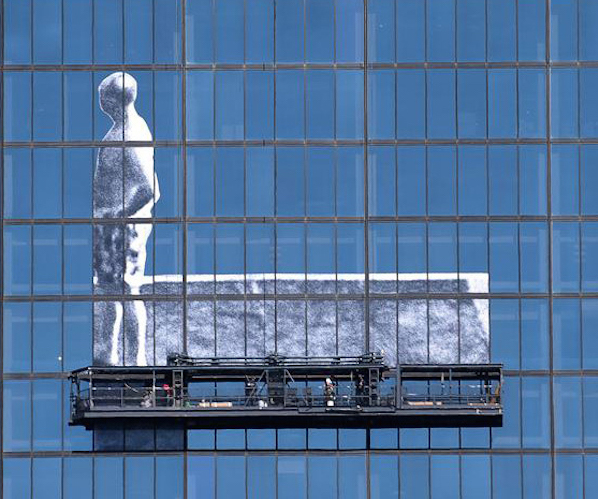
Photomural by French artist JR on Boston’s tallest building (the former Hancock Building), 200 Clarendon Street. Photo: Mark Favermann
By Mark Favermann
It simply appeared out of the blue in early fall this year. Mysterious, yet eye-catching, it was a realistic image on the façade of the former Hancock Tower, now called 200 Clarendon Street.
Set on the largest building in New England, the giant black-and-white image by French artist JR occupies window space between the 44th and 50th floors of the building (500 feet off the ground). It takes up a space 150 feet wide and 86 feet tall on the minimalist structure.
The picture popped up without any pre-publicity. The ambiguous image is made from perforated vinyl imprinted with a magnified photograph the artist took on one of his various global travels. Working in the tradition of his friend and contemporary, the more renowned but equally enigmatic street artist Banksy, JR is also an anonymous creator who been the driving force behind other similar, large-scale photographic imagery around the world.
Impressive in its size, location, and audacity, the piece’s strangeness, its generation of spontaneous wonder, is disarming. Kudos to the tower’s owners Boston Properties Inc. They have provocatively, imaginatively, and even bravely commissioned this artwork. Here, public art has been brilliantly harmonized with public relations; the goal is to re-brand the Hancock Tower as a recognizable street address. Smart art equals smart business.
JR’s is just one of a series of recent public art pieces and events that have been turning Boston’s visual environment into an unusually festive direction. How far public art has come from collections of traditional, ubiquitous bronze statues of mostly old white men! These monuments to history were inevitably planted in parks or on institutional lawns and yards! It was about time for a change.
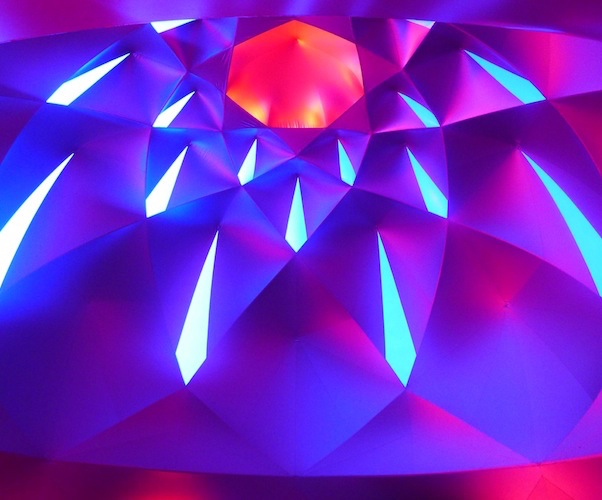
An interior view of the “Pentalum” on the Lawn on D in South Boston. Photo: Mark Favermann.
The best public art comes in many forms. It can be temporary or permanent, static or dynamic. At its most successful it needs to stimulate viewers’ imaginations through composition, content, and context.
And it is a pleasure to report that 2015 has been a high point in public art in Boston. With the exception of July 4th and the First Night fireworks, Boston has been far too conservative far too long, unforgivably timid in its adoption of contemporary visual experiences. Much of the blame for the stodginess should be directed at Boston’s traditional notion of art — both public and private — along with the biases of less than cutting-edge museums and New England’s endemic non-visual zeitgeist.
The area’s visual art ethos has been painfully safe and systemically non-experimental. Up until recently, there have been very few forays into new media and environmental art, making Boston something of a backwater when it comes to making large public visual art statements. Ironically, this is true even though there have been many creative practitioners of public art living and working in the Boston area. Primary among the latter was a group of artists/fellows who worked and studied at the now closed Center for Advanced Visual Arts at MIT, whose years spanned between 1969 and 1994. The Center’s director, the late Otto Piene, was one of the world’s great environmental artists. Little of his work was ever shown in Boston; few of the fellows from the Center had projects implemented in and around Boston either.
Though they occasionally gave lip service to public art, the Museum of Fine Arts, the Institute of Contemporary Art, and various major universities were generally adverse to large-scale environmental art projects. Slowly, with the completion of the Boston Convention & Exhibition Center (2004-5), the recent Lawn on D (2014), and the efforts of the Rose Fitzgerald Kennedy Greenway Conservancy (starting 2008), provocative public art has finally begun to be encouraged in Boston.
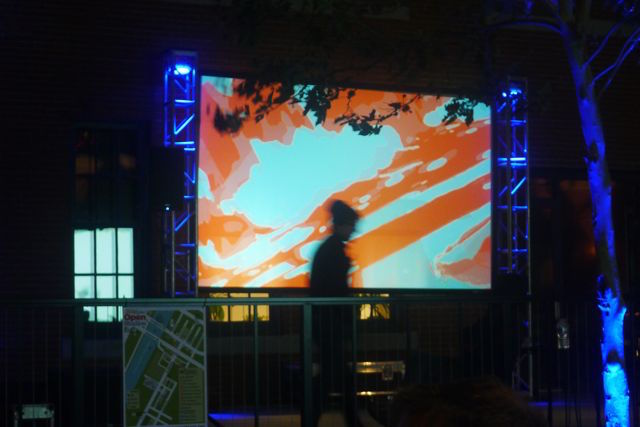
Image by John Powell from Emerson College’s multimedia event “Electric Pilgrims” at Fort Point Channel curated by Joseph Ketner, Photo: Mark Favermann.
In 1999, George Fifield began the Boston Cyberarts Festival and served as the unpaid digital arts curator at the deCordova Sculpture Park and Museum. After the erection of the large marquee in front of the Boston Convention & Exhibition Center, Boston Cyberarts set up an agreement to have digital artists program artwork on its 8-story face. Other screens are programmed at the Harbor Islands Information structure.
At first, on the edge of the Rose Fitzgerald Kennedy Greenway at the Dewey Square air vent, the ICA was the coordinating institution — it put up two huge murals by exhibiting artists. The murals changed after 18 months. The Boston MFA coordinated the third mural by an exhibiting artist at the location. Currently, coordinated by the List Center at MIT, there is a mural by conceptual/postminimalist artist Lawrence Weiner on the site. The presentations have ranged in quality — one has been controversial, others conventional — but at least their presence has continued the contemporary art conversation.
The Lawn on D has curated a number of wonderful temporary sculptural events, including an inflated maze environment (Pentalum) and some giant inflated white bunnies (Intrude), as well as the more permanent Howeler + Yoon’s LED hammocked Swing Time.
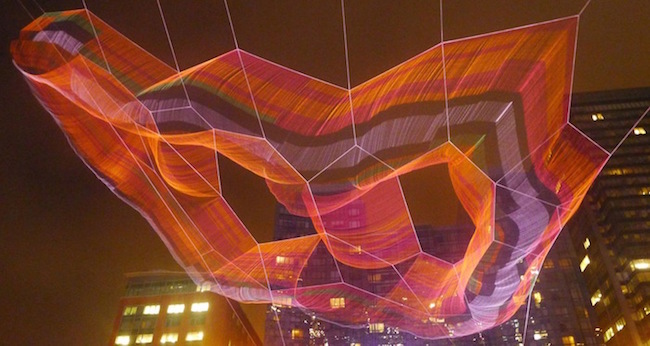
A full view (at night) of Janet Echelman’s aerial sculpture “As If It Were Already Here.” Photo: Mark Favermann.
The spectacular floating fabric/wire web sculpture by Janet Echelman, suspended over the Greenway, celebrated the longed-for coming of spring this year. This huge aerial piece made an important statement: Boston was now a real public art player. Subsequently, the Greenway has evolved into a leading venue of public art in Boston, with a series of changing temporary installations.
Another more modest but serious fostering agency for interesting public art has been the Business Improvement District (BID) at Boston’s Downtown Crossing. In that location Anita Lauricella has facilitated several public art interventions, such as Kate Gilbert’s thoughtful sight, sound, and memory piece—Color Crossing (2014).
At other venues, temporary visual art pieces have included Illuminus, a one-night program of immersive environments and video mapping that took place in the South End (2014) as well as on the backside of Fenway Park (2015). The latter event was followed a week later by Arts Emerson’s Fort Point Channel Electric Pilgrims, a gathering of sound/light projections and other interactive media.
Roxbury’s Dudley Square business district has been visually and perceptively enhanced by Crisscross Signal Spire, an interactive (activated by Twitter Tweets lit by colored LEDs) beacon by Meejin Yoon. More totem than gateway, it represents a surprising break from the past — it is surprising that a cutting edge piece like this actually won a competition in this (or in any other) Boston residential neighborhood. But times they are achangin’. Also, there is the occasional bridge lighting (such as artist John Powell’s installation at the Uphams Corner Overpass in Dorchester).
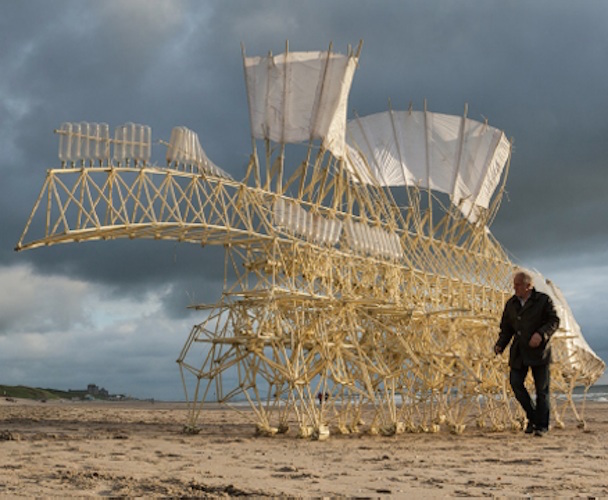
Peabody Essex Museum Exhibit and Events Strandbeest by Artist Theo Jansen with Animaris Umeris, Scheveningen Beach, The Netherlands (2009) Photo: Loek van der Klis.
In suburban Boston, the deCordova Sculpture Park and Museum has cleaned up its act and begun to seriously showcase public sculpture in some impressive exhibits. And the Peabody Essex Museum (PEM) has continued to focus on compelling environmental art events, including Stickwork by Patrick Dougherty and Theo Jansen’s Strandbeests. There also various smaller regional competitions.
The evidence is irrefutable — a new, exciting era for public art is dawning in Boston. Now we are in the midst of a visual revolution that invites us to look around and be surprised at what we see … who knows how artistic imagination will transform our environment?
An urban designer, Mark Favermann has been deeply involved in branding, enhancing, and making more accessible parts of cities, sports venues, and key institutions. Also an award-winning public artist, he creates functional public art as civic design. Mark created the Looks of the 1996 Centennial Olympic Games in Atlanta, the 1999 Ryder Cup Matches in Brookline, MA, and the 2000 NCAA Final Four in Indianapolis. The designer of the renovated Coolidge Corner Theatre, he has been a design consultant to the Red Sox since 2002. He has previously written for The Phoenix, Art New England, American Craft Magazine, Boston Herald, Blueprint (UK), Design (UK), and Leonardo.

Boston is so behind the rest of the country and many places when it comes to public art. I am happy things are finally starting to change.
Boston has over 2000 blank walls but they keep painting over murals on the wall on the Greenway